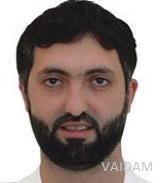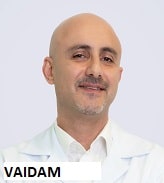The cost of VP Shunt includes:
Preoperative diagnostic tests cost (MRI, CT scan, etc.)
Surgery cost
Post-Operative cost (depends on the number of follow-up sessions)
Medicine cost
Patient's hospital stay (may need to stay for 4-5 days)
The overall cost of the procedure also varies based on the patient's condition and preferences. Some of these factors are:
Type of hospital and room opted (General, Twin sharing, or Single room)
The severity of the disease
Post-surgical complication, if it happens (such as mechanical malfunction, placement failure, infection, CSF leak)
Cost of Blood products (if required)
An extended stay at the Hospital
Cost of Accommodation during follow-ups, in case the patient is not a local resident
Listing popular specialists:

Senior Consultant, 34 years of experience

<p>Low back pain Prolapsed intervertebral disc Spinal trauma Spinal tumors Spinal fixation Brain tumors Head trauma Brain hemorrhage Stroke Epilepsy Congenital anomalies of the brain and spinal cord in children</p>

Consultant, 30 years of experience

Brain Tumors, Cerebral Palsy, Nerve Injury, Pediatric Neurology

Consultant, 25 years of experience

Spine Instrumentation, Stroke Management, Skull Base Surgery, Epilepsy Surgery, Neurotrauma (Head Injury & Spinal Cord Injury), Brain Tumour Treatment, Craniotomy, Disc Replacement ( Cervical /Lumber)

Consultant, 24 years of experience

Spinal problems and spinal surgery for adults and children; Treatment of disc diseases and spinal stenosis affecting the cervical, thoracolumbar, sacral and coccygeal region, causing pain at the neck, arms, lower-back and leg (sciatic pain) and “tail-bone” (coccyx); Use of conventional, mini-open, minimally invasive spinal surgeries, microsurgery, spinal fusion, arthroplasty techniques, spinal neuronavigation and O-arm for 3D intraoperative image acquisition; Spinal deformity, including scoliosis and hyperkyphosis, and spinal malformations; Spinal trauma (anterior and/or posterior decompression and fixation); Percutaneous kyphoplasty and spinal biopsy; Spinal tumours and cysts Spinal infections

Visiting Consultant, 35 years of experience

Brain tumors Aneurism and AVM Hydrocephalus Craniosynostosis with all type of cranial trauma Degenerative spinal disease Spinal tumors Infections and spinal dysraphism

Principal Consultant, 30 years of experience

Aneurysms chronic low-back pain

Senior Consultant, 22 years of experience

Neuro-endoscopy Stereotactic Radiosurgery Head Injury

Senior Consultant, 26 years of experience

Neurosurgery, Neuro-oncology, Skull base surgery, Reconstructive surgery for craniofacial deformities, Functional neurosurgery, Neurovascular surgery

Dr. Al Mutasim Bellah Khamees Etaiwi
Senior Consultant, 19 years of experience

Encephalocele, Myelomenengocele, Cranioplasty, Menengocele, Sacrococcegial teratoma.

Senior Consultant, 20 years of experience

Brain surgery, Spine surgery, Aneurysm clipping, Excision of skull base tumours, and Craniofacial surgeries.

Consultant, 15 years of experience

Traumatic Head Injury, Glioma, Vertebral Hemangioma, Tremors, Herniated Disc.

Consultant, 17 years of experience

Conservative treatment of neck and back pain, Minimally Invasive Spine Surgery (microsurgery, endoscopy & spinal navigation), Minimally Invasive Spinal stabilisation for Traumatic and Degenerative Diseases, Spinal Arthroplasty with Total Disc Replacement, Adult Spinal Deformity Surgery, Spinal Percutaneous Infiltrations (epidural and facet blocks)

Senior Consultant, 17 years of experience

Treatment of cranial nerve tumors, Pituitary gland and pituitary tumors, Cushing's Disease, Spinal Tumour & Infection of the Spine, Lumbar Spine Surgery / Cervical Spine Surgery / Thoracic Spine Surgery, Revision surgery

Director, 36 years of experience

Brain Tumors, Back Pain from different causes, Neck Pain with or without arm & shoulder pain, Sciatica, leg pain due to disc herniation or other causes, Degenerative Disc diseases, Spinal Stenosis, Spondylolisthesis, Spina Bifida, Spinal and Spinal Cord Tumors and entrapment syndromes, Spinal Cord Injury/Spinal Fractures, Peripheral Nerve Injury & Tumors, Failed back surgery syndrome, Revision spine surgery, Intractable Cancer pain & Neuropathic pain, Hydrocephalus/ Trauma

Consultant, 20 years of experience

Microsurgery of the Cervical, Thoracic and Lumbar Disc Herniation, Minimally Invasive Techniques for Canal Stenosis Decompression, Cervical Total Disc Replacement, Posterior Cervical Stabilization with pedicel and lateral mass screws, Minimally invasive percutaneous techniques for vertebral fractures including vertebroplasty kyphoplasty, spine stabilization

Head of Department, 23 years of experience

Minimally Invasive Spine Surgery, Spinal Tumors, Spina Bifida, Hydrocephalus

Consultant, 15 years of experience

Spine Surgery, Spinal Tumors

Consultant, 20 years of experience

Neurosurgical trauma, Hydrocephalus, Peripheral nerve lesions

Dr. Muhammed Khalid Naseen Chishti
Consultant, 30 years of experience

Brain tumors, Aneurysm and AVM, Hydrocephalus, Craniosynostosis with all types of cranial trauma, Degenerative spinal disease, Spinal tumors, Infections and spinal dysraphism

Consultant, 24 years of experience

Neurocysticercosis Cranial Surgery
Our Services for Vp Shunt in United Arab Emirates
Transparent - Professional - Without Hassles
You won't be able to see the catheter because it will be under your skin. However, you may be able to feel the shunt catheter along your neck. Once all the parts of the shunt are connected, it will start draining the excess CSF as needed to reduce the pressure in your brain.
It can last from a few days or weeks to many years. In adults we have seen them last for as long as 35 years. Over time the plastic tube can corrode and disintegrate, requiring a new shunt to be inserted.
There are different indications for programmed vs unprogrammed shunt, Programmed is usually done in elderly individuals and congenital hydrocephalus while unprogrammed is chosen for tumors, hydrocephalus and meningitis.
WHO regulation says it may require a change every 5 years so there are less chances of blockage.
Usually for 5 days.
The entire procedure takes about 90 minutes.
Usually for 5 days.
There are different indications for programmed vs unprogrammed shunt, Programmed is usually done in elderly individuals and congenital hydrocephalus while unprogrammed is chosen for tumors, hydrocephalus and meningitis.
It can last from a few days or weeks to many years. In adults we have seen them last for as long as 35 years. Over time the plastic tube can corrode and disintegrate, requiring a new shunt to be inserted.
You won't be able to see the catheter because it will be under your skin. However, you may be able to feel the shunt catheter along your neck.
Once all the parts of the shunt are connected, it will start draining the excess CSF as needed to reduce the pressure in your brain.
Depending on the circumstances, a VP shunt can be temporary or permanent. If the cause of your hydrocephalus is idiopathic (unexplained), congenital (present from birth), or the result of a defect in the anatomy of the brain or spine, there is a strong chance that you will need to have your VP shunt for the long term.
No followup visit is required once patient has been reviewed for about 3 weeks
Most of the hydrocephalic patients will be required to keep their CSF shunt all life long. One of the advantages of this therapy is that it allows you to have a normal daily life. The shunt will restore the CSF circulation to regulate its flow.
WHO regulation says it may require a change every 5 years so there are fewer chances of blockage.
Most of hydrocephalic patients will be required to keep their CSF shunt all life long. One of the advantages of this therapy is that it allows you to have a normal daily life. The shunt will restore the CSF circulation to regulate its flow.






NABH Certified Healthcare Discovery Platform
Vaidam is NABH certified healthcare discovery platform that will connect you to top-notch medical experts, hospitals, wellness options, and trusted travel partners to help identify and make the right healthcare choices.

Researched & Personalized Treatment Plan - Under One Roof
You can search for the best hospitals, read about them, view photographs of the facilities at the hospitals and the places at which the hospitals are located, and check the cost of treatment.

Quality Treatment Within Your Budget
As soon as you post an enquiry, the patient relation team will collect details from you, share them with the doctors and hospitals on Vaidam's panel, and get a personalized treatment plan. We research to get quality treatment within your budget.

Treatment to Travel
Vaidam concierge assists patients, to get medical Visa, the best airline fares and arrangements for your stay. Our concierge also helps you with daily travel, language, and food concerns. Vaidam does everything to be your perfect host. All of Vaidam’s services are free of cost to patients.

International Reach
Vaidam Health has network in 15+ countries, which includes India, Turkey, UAE, Germany, South Korea, Thailand, Malaysia, Spain.
Note: Vaidam Health does not provide medical advice, diagnosis or treatment. The services and information offered on www.vaidam.com are intended solely for informational purposes and cannot replace the professional consultation or treatment by a physician. Vaidam Health discourages copying, cloning of its webpages and its content and it will follow the legal procedures to protect its intellectual property